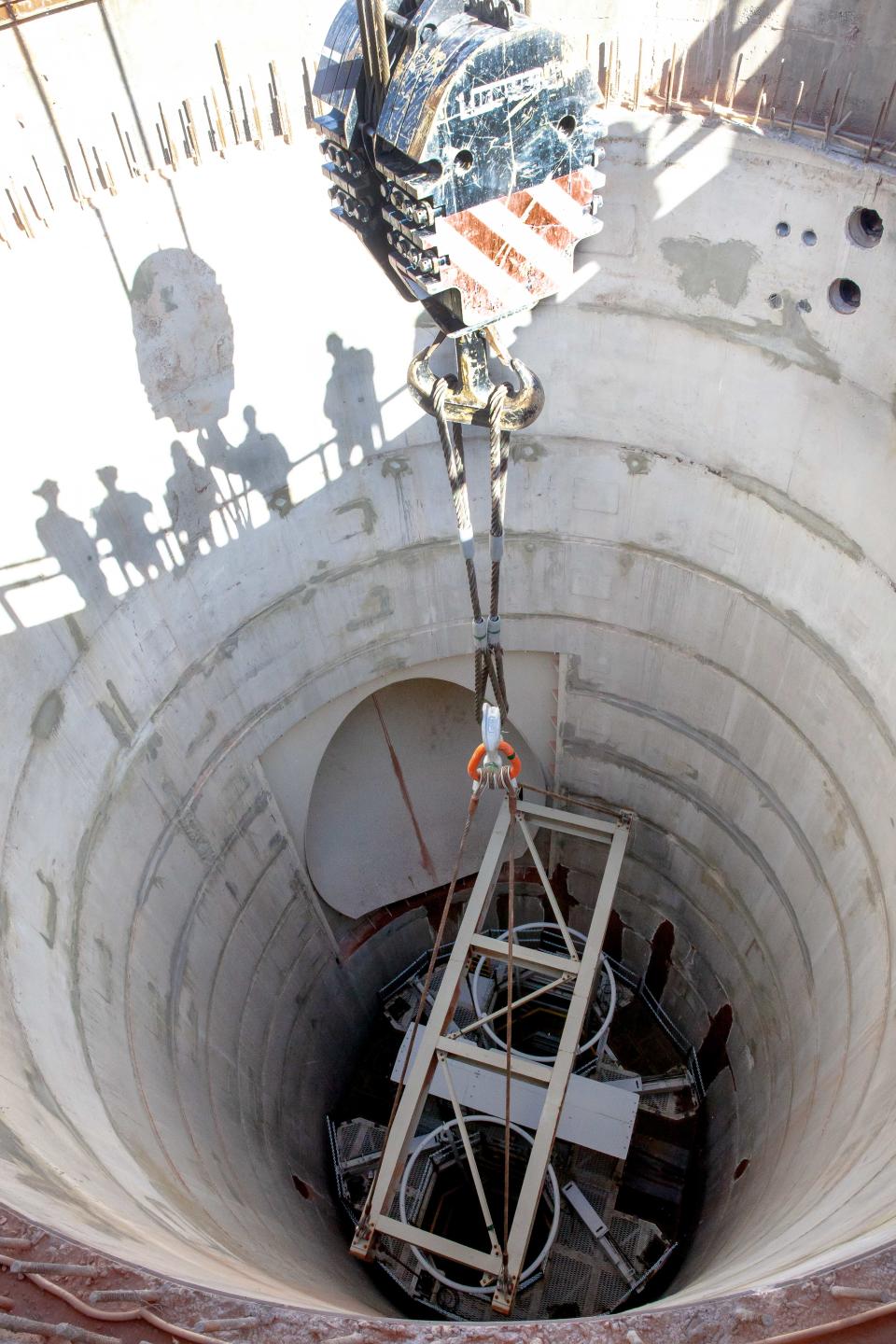WIPP's elevator encounters additional problems
A series of incidents were reported in recent months at an elevator and utility shaft being built at the Waste Isolation Pilot Plant nuclear waste repository near Carlsbad, drawing concerns from a government watchdog agency as to the safety of the facility’s mine.
WIPP disposes of transuranic (TRU) nuclear waste in a underground salt deposit about 2,000 feet beneath the surface about 30 miles east of Carlsbad.
The waste is brought underground using a hoist, while mined salt is brought to the surface using a separate elevator.
More: Court blocks proposed Holtec International nuclear waste site in New Mexico
Two miners were stuck in the waste hoist when it malfunctioned Jan. 23 and was stuck about 1,500 feet underground as it moved down into the underground, according to the March report from the Defense Nuclear facilities Safety Board.
Staff at the site reported a faulty digital signal tripped a breaker and cut power to the hoist’s controller, the report read. This caused the brake system to automatically stop the man cage’s descent, and the hoist was lowered about another 500 feet to the bottom of the shaft within 30 minutes of the incident.
The report noted that WIPP operator Salado Isolation Mining Contractors failed to properly report the incident as the contractor contended the incident did not present an unsafe condition as food, water and an “eventual escape” was conducted for the miners, read the report.
More: Feds lose appeal of vacated license for nuclear waste storage site in Permian Basin
The Defense Nuclear Facilities Safety Board disagreed, concluding that losing control of the waste hoist constituted an “unsafe condition,” the report read, and should have been reported when it occurred in WIPP’s Occurrence Reporting and Processing System (ORPS).
“The Board’s staff consider a loss of hoist control due to the power outage to be an unsafe condition that was properly mitigated by the credited braking system. “It appears that this event should have been reported in the ORPS.”
Mark Bollinger, manager of the Department of Energy's Carlsbad Field Office (CBFO) said the workers were kept safe throughout the event.
More: 'State consent' on nuclear stripped from Senate bill
“The safety of our workforce is always our top priority,” she said in an emailed statement. “The workers in the hoist remained in a secure environment during the entire incident and continuous communication was maintained with the employees until power was restored.”
In the same report, the Board also found water flowing into a utility shaft under construction, potentially dissolving the salt and leading to structural problems for the shaft.
The ongoing project, WIPP’s fifth such shaft, was estimated to cost $100 million and expected to be completed by 2026 after numerous delays since work began in 2019. When complete, the shaft will act as an air intake for an almost half-billion-dollar rebuild of the site’s ventilation system.

More: Nuclear waste site near Carlsbad to double in size, take waste until 2083, officials say
Most recently, work on the shaft was suspended after a cable connected to a material handling basket snapped and dropped the basket to the bottom of the shaft. This was caused by the basket becoming misaligned with the shaft, records show, and colliding with the edge.
At the time, that was the third hoist-related incident in about a month, read a previous report, and led to a temporary order to stop work on the shaft.
For the most recent problem at the shaft, a dolomite layer about 20 feet thick was found fractured, read the March report, at about 800 feet down the shaft just above the “salt seam” where groundwater is known to flow.
More: WIPP marks 25 years of operation in southeast New Mexico
At about 780 feet, the Board reported water continued to flow into the utility shaft at about 1.3 gallons per minute. Subcontractor for the project Harrison Western Shaft Sinkers planned to repair the opening in the liner allowing water to flow in, read the report, and began pumping water out of the shaft on Feb. 19.
Pumping concluded on Feb. 24 after removing about 140,000 gallons, the report read, with inspections conducted and work resuming that month. Bollinger said WIPP workers were collecting the intruding water in a temporary holding “collar” at the bottom of the shaft and regularly move it to the surface.
“Accumulated water was removed and work through the shaft resumed in February 2024 after geotechnical investigations confirmed that the shaft was structurally sound,” Bollinger said. “We are currently evaluating long-term resolutions to the water intrusion.”
More: Holtec's New Mexico nuclear waste proposal questioned during federal court hearing
The report did note a problem in the underground was being allayed as SIMCO began funding work to repair the salt pocket where mined salt is stored before being transported to the surface.
The pocket was previously reported as gradually collapsing as the salt “creeped, placing stress on infrastructure.
Bollinger said the salt shaft was in good condition and full operational. She said the project to repair the salt pocket will cost more than $15 million and take about three months.
“It remains our goal to invest in WIPP’s aging infrastructure to keep facilities safe and operational for our workforce, the public and our mission,” Bollinger said. “Funds have been identified to support necessary upgrades to the salt pocket.”
Adrian Hedden can be reached at 575-628-5516, achedden@currentargus.com or @AdrianHedden on the social media platform X.
This article originally appeared on Carlsbad Current-Argus: Problems with Waste Isolation Pilot Plant's elevators reported

